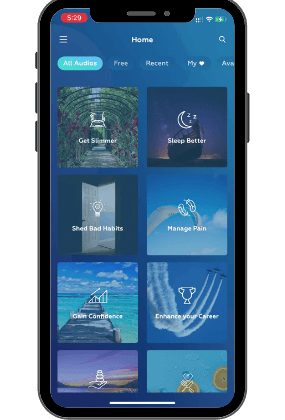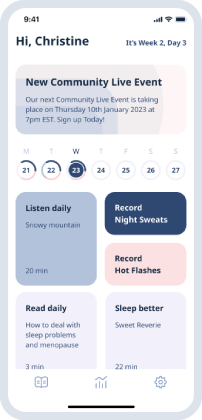
Effects of Menopause, Menopausal Symptoms, and When They Often Begin

Hypnotherapy for Digestive Health and Regaining Control Over IBS
Table of contents
- What is Autosuggestion?
- What is an Example of Autosuggestion?
- How does Autosuggestion Differ from Heterosuggestion?
- Which Therapies Use Autosuggestions?
- What is the Difference Between an Auto-Suggestion and Positive Affirmations?
- Can Autosuggestion Trigger Feelings?
- What’s the Difference Between Autosuggestion and Placebo?
- What Do Researchers Say about Autosuggestion?
- Are Autosuggestions Necessarily Positive Statements?
- Benefits of Autosuggestion
- How to Practice Autosuggestion?
- Other Practical Tips to Incorporate into Your Daily Routine
- Autosuggestion to Empower Yourself
Autosuggestions, also known as self-suggestions or affirmations, refer to the practice of repeating positive affirmations to oneself to achieve personal growth and improvement. Autosuggestions have been used for centuries and are gaining popularity in today’s fast-paced world to reduce stress and anxiety and improve overall wellbeing.
In this blog, we will explore autosuggestions, their inner workings, and how they can enhance your life.
What is Autosuggestion?
Autosuggestions are self-talk techniques used to reprogram our subconscious mind. In simpler terms, autosuggestions are positive affirmations that we repeat to ourselves to change our thought patterns and behavior. The idea is to train our minds to focus on what we want rather than what we do not want.
This goal is reflected in the synonyms for autosuggestion. For example, many people might refer to self-suggestion, self-induced suggestion, self-administered suggestion, self-influence via thoughts, self-regulation, or top-down control.
In addition, autosuggestions require three features:
- They are expressed through words, said either internally or out loud, which can be reinforced with imagery.
- They are repeated multiple times before they can start to influence perceptions.
- They lead to changes in perceptions and feelings (or brain states).
What is an Example of Autosuggestion?
One of the best-known examples of autosuggestion is Emile Coué’s famous affirmation:
“Every day in every way, I am getting better and better.”
The French pharmacist noticed in the early 20th Century that patients’ recovery depended not fully on the medication they received but also on what he said when dispensing it.
We use auto-suggestion every day. For example, believing that it is lunchtime can make you hungry.
How does Autosuggestion Differ from Heterosuggestion?
One key difference between autosuggestion and heterosuggestion is the type of control one has over the process. Additionally, by repeating affirmations to oneself, the individual can internalize and own the message. With autosuggestion, the individual has complete control over the affirmations they repeat to themselves and how they do so. self-induced suggestion allows for greater customizability, as the individual can tailor their affirmations to their specific goals and needs.
But this flexibility comes with a disadvantage. First, one needs to know how to craft good suggestions.
People increasingly prefer to rely on someone who can craft beneficial suggestions. Most therapies, including hypnotherapy, use heterosuggestions, i.e., suggestions from an external party. The suggestions are potentially better, and the to-be-suggested person might benefit from the external validation or approval provided by a third party like a family member.
Which Therapies Use Autosuggestions?
Many therapies use autosuggestions. We will delve into the field of self-hypnosis, hypnotherapy, autogenic training, and cognitive behavioral therapy.
Hypnotherapy & Self-Hypnosis
An increasingly popular therapy that uses autosuggestions is hypnotherapy. Hypnotherapy employs hypnosis techniques to overcome various mental health problems, such as anxiety, depression, and addiction. During a hypnotherapy session, the hypnotherapist may use autosuggestions to suggest positive changes. For example, a therapist may provide the hypnotic suggestion that they feel more confident and self-assured in social situations.
In addition, the therapist might craft different types of suggestions, including posthypnotic suggestions, to reinforce the desired positive behaviors and thought patterns.
Self-hypnosis refers to the same focused state of awareness when self-induced. To maximize your relaxation, you can sit comfortably on a chair or lie down. Then, like in a therapist’s room, you can listen to a hypnotherapist’s voice guiding you through a hypnotic induction, followed by heterosuggestions, autosuggestions, and guided imagery.
These suggestions help re-frame beliefs and generate more helpful thought patterns and behaviors. Hypnosis is the only mind-body technique allowed in operating theatres to facilitate analgesia (i.e., pain management).
Autogenic Training
Autogenic training is a relaxation technique inspired by hypnosis. The German psychiatrist who created autogenic training in the 1920s, Johannes Heinrich Schultz, noticed that people enjoyed deep relaxation in hypnosis.
Schultz helped patients recreate a state of focused awareness, i.e., hypnosis, by bringing their attention to different parts of the body and repeating a series of positive affirmations designed to induce a relaxed state in the body. Some examples of these suggestions may include phrases such as “My arms and legs feel heavy and warm,” “My breathing is deep and calm,” and “I feel calm, peaceful, and relaxed.”
The word “autogenic” means “generated from within, “which reflects the technique’s focus on utilizing the power of the mind to facilitate desired bodily perceptions and therefore induce a state of relaxation and reduce stress.
To initiate autogenic training, you can follow the same process as self-hypnosis. You can sit comfortably on a chair or the floor or lie down before focusing on each of these suggestions.
Cognitive Behavioural Therapy
Cognitive-behavioral therapy (CBT) is another therapy that uses suggestions for the connection between thoughts, emotions, and behavior. It acknowledges that negative thought patterns and beliefs can contribute to mental health problems such as anxiety, depression, and phobias.
During CBT sessions, clients are encouraged to identify and challenge negative thought patterns before replacing them with positive ones. In other words, clients are encouraged to move away from negative things and instead consider other factors.
Autosuggestions are often used as a way to reinforce the positive thoughts and beliefs that are established during therapy. Clients may be encouraged to repeat positive affirmations to themselves, either in session or at home, in order to reprogram their minds and promote positive change.

What is the Difference Between an Auto-Suggestion and Positive Affirmations?
The terms autosuggestion and positive affirmations are often used interchangeably, yet there is a subtle difference between the two. Both involve using positive thoughts and words to influence one’s mind and behavior, but the main conceptual difference lies in the source of the suggestion.
Autosuggestion refers to the practice of suggesting ideas or affirmations to oneself. Said differently, autosuggestions are self-generated thoughts and ideas designed to reprogram the subconscious mind with positive beliefs and attitudes. In other words, it involves creating positive self-talk to boost confidence, self-esteem, and motivation.
Positive affirmations, on the other hand, can come from an external source, such as a friend, mentor, or therapist. Positive affirmations are statements of encouragement and support that are designed to boost one’s mood and confidence. These affirmations can also involve self-talk, but they are not exclusively self-generated. When accepted fully, a positive affirmation can become an autosuggestion.
Can Autosuggestion Trigger Feelings?
Autosuggestion can trigger feelings through the repetition of positive statements to change one’s thought patterns, beliefs, and behavior. For example, when a person repeatedly affirms something positive about themselves or their situation, it can create a shift in their mindset and lead to feelings of empowerment, confidence, and self-worth.
For example, if someone consistently tells themselves, “I am capable and deserving of success,” they may begin to feel more confident and motivated to pursue their goals. Similarly, repeating positive affirmations related to emotional healing can help a person become more proactive and move towards a more positive outlook.
What’s the Difference Between Autosuggestion and Placebo?
Both autosuggestion and placebo use suggestions to influence a person’s thoughts, feelings, and behaviors. However, there are some critical differences between the two.
Autosuggestion is a self-induced process in which a person repeats positive affirmations encouraging a desired change in their thoughts. This process is usually done with the intention of improving one’s mental, emotional, or physical well-being.
Conversely, placebo is an external treatment or intervention without any active therapeutic ingredients or effect. However, the person’s belief in its effectiveness might influence their expectation and perception, creating positive results. The delivery method for this intervention can in itself be a suggestion, which becomes an autosuggestion when internalized by the patient. This phenomenon, the placebo effect, does not necessarily require repetition.
What Do Researchers Say about Autosuggestion?
Over the years, researchers have conducted many studies on autosuggestion and its effectiveness in promoting positive change in individuals. Here are some of their findings:
- Autosuggestion can help improve mental health: self-hypnosis with its directed attention, use of imagination, and suggestion can alleviate stress, and reduce the symptoms of anxiety and depression.
- Autosuggestion can improve the quality of life and strengthen the immune system. A 2017 study on 51 geriatric patients showed a better quality of life, stronger immunity, and lower cortisol levels for the autosuggestion group vs. the control group.
- Autosuggestion alone and hypnosis using posthypnotic suggestions can lead to behavior change and better decisions: one study showed that posthypnotic suggestions could encourage better decisions related to snacks, and the effect was more significant for the hypnosis group than for the autosuggestion-alone group.
- Autosuggestion can enhance performance: according to research, individuals who engage in positive self-talk through autosuggestion tend to perform better on cognitive tasks, such as memory recall and problem-solving.
- Autosuggestion can help relieve the sensation of pain by decreasing pain thresholds according to several studies. One study reported that a self-hypnosis program using suggestions can alleviate headaches.
Overall, researchers suggest that autosuggestion can be an effective tool for promoting positive change in individuals, especially when combined with other therapeutic approaches such as hypnosis and lifestyle changes.
Some researchers also hypothesized that autosuggestion might involve the ‘overwriting’ of existing predictions of the most common – and potentially unwanted – outcome.
Are Autosuggestions Necessarily Positive Statements?
An autosuggestion does not need to be positive. Unfortunately, most people looking for a coach or therapist suffer from negative self-talk, i.e., negative autosuggestion.
A Harvard study concluded that we have about 60,000 thoughts daily, most of which we are unaware of. How many of them are positive statements vs neutral and negative affirmation?
One of the worst negative affirmations is “I am not good enough.” These five words are enough to stop you in your tracks by removing the motivation to persevere.
Benefits of Autosuggestion
There are several potential benefits of autosuggestions, some of which are listed below:
- Promotes positive thinking and mental wellbeing
- Helps in setting and achieving goals
- Enhances self-esteem and confidence
- Improves focus and concentration
- Reduces stress and anxiety and therefore improve sleep
- Boosts productivity
- Improves overall quality of life
- Improve relationships
- Let’s focus on two strategies below.
Personal Growth
Autosuggestion can be a powerful tool for personal growth and self-improvement. Here are some benefits of autosuggestion for personal growth:
- Increases self-awareness: Through beneficial self-talk, individuals can become more aware of their beliefs, thought patterns, and behaviors. This can help identify areas for personal growth and improvement.
- Builds confidence and self-esteem: autosuggestion can help individuals build confidence and self-esteem by focusing on their strengths, capabilities, and achievements.
- Enhances motivation: Autosuggestion can encourage individuals to pursue personal growth goals by increasing their motivation, energy, and determination.
- Encourages positive mindset: With consistent practice, autosuggestion can help shift an individual’s mindset towards positivity, leading to a more optimistic outlook on life and increased resilience.
Autosuggestion requires a commitment to repeating the same suggestion as long as necessary. This regular practice might deter many from using autosuggestion alone. However, when used in frameworks like hypnotherapy and self-hypnosis, its efficacy might be enhanced and the intervention period reduced.

Pain Management
Autosuggestion can become a complementary approach to pain management. Here are some benefits of autosuggestion for pain management:
- Promotes relaxation: The relaxation techniques used in autosuggestion can help reduce muscle tension, slow down breathing, and decrease heart rate, which can help reduce pain levels. Autogenic training relies on useful autosuggestions to encourage relaxation.
- Changes in pain perception: By focusing on positive autosuggestions and visualizations, individuals can shift their perception of pain and their ability to cope with it.
- Reduces anxiety and stress: Autosuggestion can help reduce anxiety and stress, both of which can exacerbate pain levels.
- Improves mood: By promoting positive thoughts and feelings, autosuggestion can improve mood and emotional well-being, making it easier to cope with chronic pain.
- Encourages self-care: Regular use of autosuggestion can encourage individuals to take an active role in their pain management, promoting self-care practices such as exercise, healthy eating, and stress reduction techniques.
Overall, autosuggestion is a safe and non-invasive method complementing traditional approaches to pain management. In cases of intense or acute pain, it may not be enough. Remember to consult with a healthcare professional when experiencing pain to determine the best course of action.
The Power of Self-Talk
Self-talk refers to the internal dialogue or conversation, the way a person talks to themselves mentally or out loud. Engaging in self-talk is not a sign of folly; it can help us focus on a particular thought, and build self-esteem, confidence, and resilience over the medium term. Conversely, negative self-talk has the opposite effect; it can fuel self-doubt, anxiety and depression.
But what does self-talk have to do with autosuggestion? When people engage in positive self-talk, they give themselves positive autosuggestion and focus on their strengths, abilities, and accomplishments, which can increase their motivation, optimism, and overall sense of well-being.
On the other hand, negative self-talk – with its constant focus on “negative things” – can create a self-defeating cycle of pessimism, self-criticism and feelings of inadequacy. These negative autosuggestions become habitual and lead to negative beliefs about oneself, influencing one’s behavior and performance.
The conscious act of replacing negative thoughts with positive ones is the first step in crafting a useful autosuggestion, paving the way for a shift in mindset towards more constructive and empowering perspectives.
How to Practice Autosuggestion?
Step by Step Process
- Set your intention: Decide which area of your life you would like to focus on or what behavior you would like to change. Next, identify the specific affirmation(s) that you will use to support this intention.
- Find a quiet and comfortable place: Sit or lie in a comfortable position where you will not be disturbed.
- Relax your body: Take a few deep breaths, close your eyes, and allow your body to relax.
- Repeat the autosuggestion: Repeat the positive affirmations you chose for yourself. You can do this out loud or silently in your mind. For example, if you intend to build self-confidence, your autosuggestion might be, “I am confident and capable in all areas of my life.”
- Visualize the outcome: As you repeat the autosuggestion, imagine yourself already changing your behavior. This form of visualization can help evolve your perception and reinforce the positive messages you tell yourself.
- Repeat the autosuggestion consistently: It’s essential to repeat the affirmations consistently, ideally daily. Repeat them with conviction and belief.
With consistent practice, you can create a more positive and fulfilling life experience. But if you are not ready to commit to using an autosuggestion for an extended period of time and would like to supercharge your progress, you can start using self-hypnosis.
Using Self-Hypnosis
Are you new to self-hypnosis, with limited access to certified hypnotherapists? By choosing hypnosis, you are choosing a method that combines imagination, focus/attention, and autosuggestion to help you achieve a happier and healthier life. Here are some steps to practice autosuggestion using a self-hypnosis app:
- Find a quiet and comfortable place where you will not be disturbed.
- Sit or lie down in a comfortable position and close your eyes.
- Take a few deep breaths and relax your body.
- Follow your hypnotherapist’s voice guiding you into relaxation.
- Immerse yourself in the guided self-hypnosis
- Follow all the instructions from start to finish
Your hypnosis programs do the heavy lifting for you. The UpNow hypnosis audios include a variety of methods, such as repeating positive autosuggestions to yourself out loud or silently in your mind, imagining yourself already experiencing the desired outcome. A few minutes are packed with what you need to experience improvement over time.
Other Practical Tips to Incorporate into Your Daily Routine
Autosuggestions can make a positive impact on your life and require an application. Their repetition is one of the key factors of a successful auto-suggestion program. If you are not sure how to frame them or feel like you could do with some help, here are several ways to incorporate autosuggestions in your daily routine, some of which are listed below:
- Daily self-hypnosis practice through a self-hypnosis app
- Creative visualization during the hypnotic process
- Journaling
- Encourage Positive Self-Talk
Crafting an autosuggestion is truly an art, and you need to follow some basic rules to avoid making a negative suggestion.
- Be Consistent
- Be Specific and Concise
- Use Present Tense
- Make it Believable
- Use Emotions
- Use Visualization
- Don’t use any negation in your autosuggestion
Autosuggestion to Empower Yourself
Autosuggestion can help you make positive changes in your life. With the use of positive affirmations, your self-talk can improve, and your mindset can shift towards more positivity as you build confidence and enjoy greater motivation. No wonder that many therapies have incorporated the use of autosuggestion in their protocol.
By incorporating this simple yet effective technique into your daily routine, you can empower yourself to live a more fulfilling and rewarding life. This outcome requires well-crafted autosuggestion, regular practice, and dedication to the process.
A self-hypnosis program incorporates proper autosuggestion through a structure that requires less than 30 minutes of your daily time. Imagine just putting on your headset in a comfortable room, pressing the play button, and closing your eyes while your hypnotherapist voice speaks to you!
Check out for yourself and download the UpNow app today!
UpNow Health only uses high-quality sources, including peer-reviewed articles, to support the facts within our articles. Experts review all our articles to ensure that our content is accurate, helpful, and trustworthy.
1. Myga, K.A., Kuehn, E. & Azanon, E. Autosuggestion : a cognitive process that empowers your brain? Exp Brain Res 240, 381–394 (2022). https://doi.org/10.1007/s00221-021-06265-8
2. Sari, N. K., Setiati, S., Taher, A., Wiwie, M., Djauzi, S., Pandelaki, J., Purba, J. S., & Sadikin, M. (2017). The role of autosuggestion in geriatric patients’ quality of life: a study on psycho-neuro-endocrine-immunology pathway. Social Neuroscience, 12(5), 551–559. https://doi.org/10.1080/17470919.2016.1196243
3. Wager, T. D., Rilling, J. K., Smith, E. E., Sokolik, A., Casey, K. L., Davidson, R. J., Kosslyn, S. M., Rose, R. M., & Cohen, J. D. (2004). Placebo-induced changes in FMRI in the anticipation and experience of pain. Science (New York, N.Y.), 303(5661), 1162–1167. https://doi.org/10.1126/science.1093065
4. Ter Kuile, M. M., Spinhoven, P., Linssen, C. G. A., Zitman, F. G., Van Dyck, R., & Rooijmans, H. G. M. (1994). Autogenic training and cognitive self-hypnosis for the treatment of recurrent headaches in three different subject groups. Pain, 58(3), 331–340. https://doi.org/10.1016/0304-3959(94)90127-9
5. Ludwig, V. U., Stelzel, C., Krutiak, H., Magrabi, A., Steimke, R., Paschke, L. M., Kathmann, N., & Walter, H. (2014). The suggestible brain: posthypnotic effects on value-based decision-making. Social cognitive and affective neuroscience, 9(9), 1281–1288. https://doi.org/10.1093/scan/nst110
6. Staats, P., Hekmat, H., & Staats, A. (1998). Suggestion/placebo effects on pain: negative as well as positive. Journal of pain and symptom management, 15(4), 235–243. https://doi.org/10.1016/s0885-3924(97)00363-1
7. Hatzigeorgiadis, A., Zourbanos, N., Galanis, E., & Theodorakis, Y. (2011). Self-Talk and Sports Performance: A Meta-Analysis. Perspectives on psychological science : a journal of the Association for Psychological Science, 6(4), 348–356. https://doi.org/10.1177/1745691611413136
8. Oakley, D. A., & Halligan, P. W. (2013). Hypnotic suggestion: opportunities for cognitive neuroscience. Nature reviews. Neuroscience, 14(8), 565–576. https://doi.org/10.1038/nrn3538
















